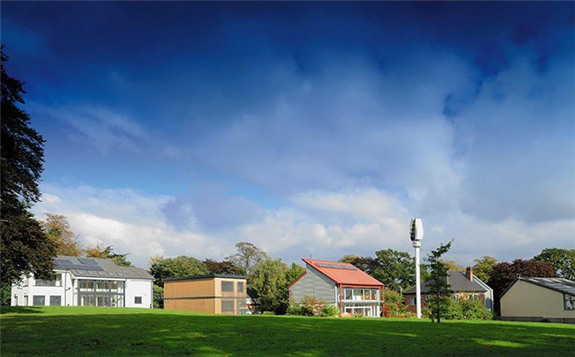THE University of Nottingham, UK has received £1.3m (US$1.8m) for a project to develop a novel, low-carbon energy storage system to supply cheap, on-demand heat for houses and buildings in UK neighbourhoods. The technology could help decarbonise the building sector, while also addressing issues of fuel poverty and pollution.
As part of its Clean Growth Strategy, the UK Government announced plans to phase out the installation of high-carbon fossil-fuel heating in new and existing buildings during the 2020s. According to Jo Darkwa, “we need low carbon and zero carbon heating systems that can replace fossil-fuelled systems”, because gas boilers will not be an option beyond 2030. Darkwa is a Professor of Energy Storage Technologies in the Faculty of Engineering at Nottingham.
The team intends to develop a flexible and smart heat storage system that can help overcome the difficulties of using low-zero carbon sources of energy within district heating systems. According to Darkwa, a key alternative to replace fossil-fuelled heating systems is district heating systems which distribute hot water into multiple properties via networks of communal pipes.
He says: “District heating systems are advantageous, because they can use excess heat – a free raw material – from industrial processes or sustainable sources such as geothermal to heat water for large numbers of homes. It’s very common in Scandinavia, Germany, and China.”
Darkwa adds that district heating systems are ideally placed to overcome the issues of mismatch between energy demand and availability associated with the variable nature and temperatures of low-zero carbon sources, in urban settings.
However, they require suitable energy storage facilities that can cope with an influx of varying sources of temperature. For example, Darkwa says commercial waste heat is has a much higher temperature than solar thermal heat. He highlights that a flexible, smart system that could collect heat from different sources and temperatures and store it appropriately would maximise supply.
Currently, there are limited effective ways to store recovered waste heat for later use. The project at Nottingham is aimed at overcoming the technical challenges that limit the capabilities of conventional thermochemical energy storage systems.
The team intends to develop “unique” double-acting agitated heat recovery and heat charging mechanism to store and discharge heat. The system would consist of two fluidised beds of inorganic oxide components with high energy density, that can store heat and later be reactivated through a chemical reaction.
Through their three-year project, the researchers aim to identify the most effective material to store heat for later release. Basic materials are commercially available but have limitations, according to the researchers. The project will involve characterising available options in labs and then enhancing their heat transfer characteristics.
Additionally, a mechanism and material will be developed for the project to enable the novel proposed system to operate continuously at variable temperatures. This would differ from conventional thermochemical energy storage systems which require intermittent operation.
According to Darkwa, the planned system would also be decentralised, thereby minimising heat lost through long communal heating pipe systems; enabling energy to be retained in an absorbed state, with near-zero losses; and potentially allowing inter-seasonal storage. This, for example, could see solar energy stored in summer during low demand, and discharge in winter during high demand.
Researchers intend for the planned system to be relatively cheap to run compared to conventional systems which store heat in large water tanks at fixed temperature. At the domestic level it would remove fossil cost and the financial burden of boiler purchase, servicing, and maintenance.
In addition to developing a heat storage system, the research project will involve investigating the social, economic, environmental barriers that prevent uptake of community-based heat networks in the UK.

Once the proposed thermochemical energy storage system is tested and operational, a pilot will be connected to the small-scale district heating network already in operation at the Creative Energy Homes complex at the Nottingham campus. The test-bed demonstrator will then be evaluated for effectiveness and performance. Creative Energy Homes is £1.9m project. It’s a seven-house development that provides a living test-site for companies, including BASF, to work with the University to investigate the integration of energy efficient technologies into houses.
Lord Martin Callanan, Minister for Climate Change and Corporate Responsibility commented: “The way we use energy in our buildings makes up almost a third of all UK carbon emissions. Reducing that to virtually zero is going to be key to eradicating our contribution to climate change by 2050.
“That’s why it’s important that innovative projects … receive backing to develop new and effective ways to heat and cool our homes and workspaces, helping drive down the costs of low-carbon technologies so everyone can feel the benefits of cheaper and greener energy.”
Sally Longford, Nottingham City Council’s Deputy Leader and Portfolio Holder for Energy, Environment & Waste Services, said: “Decarbonisation of heat is a key challenge we need to find solutions for, and we’re interested to find out if this approach being piloted by the University of Nottingham could be applied to our own district heating network.”
According to project partners, gathering statistical data from real-life communities to evaluate the effectiveness of technology is vital for delivering a product that has buy-in from future users and is capable of meeting their disparate heating needs.
Nottingham City Council is a key partner in the project. The city aims to be carbon neutral by 2028.